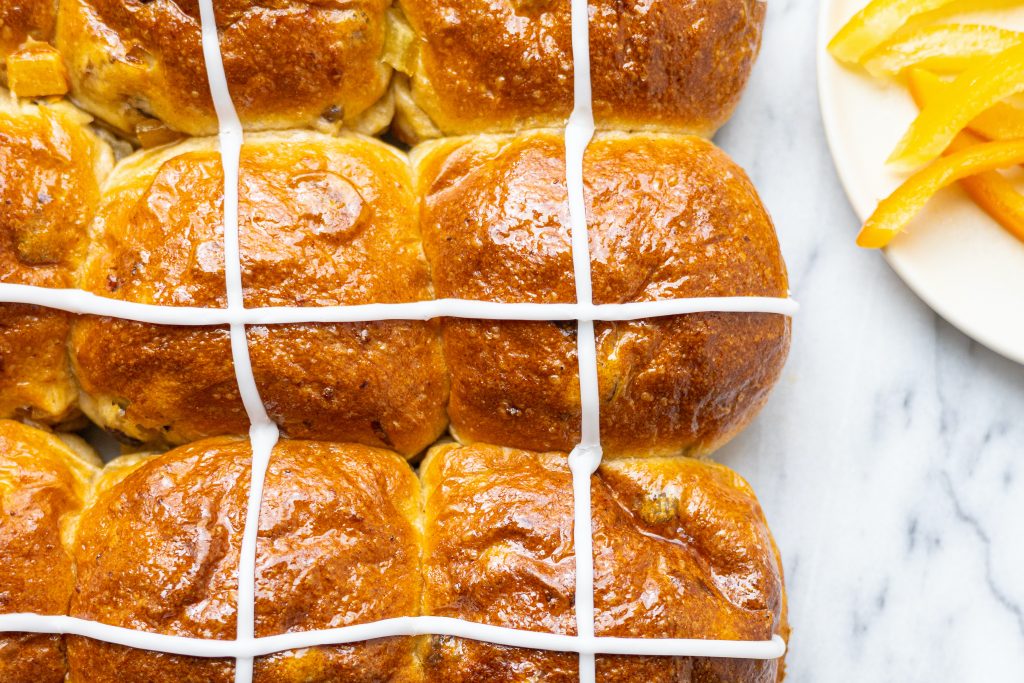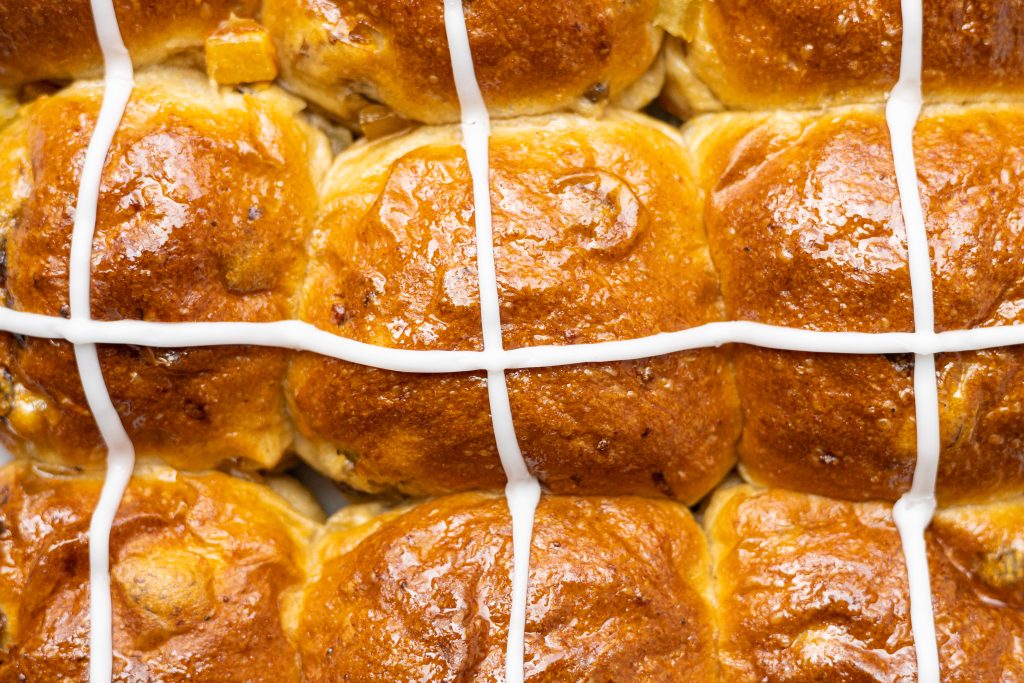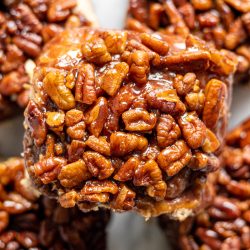Last year we shared with you a post about the long and storied history of Hot Cross Buns. Since last Easter, we’ve been dreaming of making our version even tastier. We liked what we were doing, but we are never 100% satisfied. At the outset, our goal was to make our buns more moist and more flavorful, and I think we’ve done it–our new version literally makes me giddy! I know, it’s a little weird, but I guess my ability to be super excited about this is why I have been able to devote my life to baking.

What did we do? We made three major changes—altered the ingredients, adjusted the technique, and changed the proportions of the fruity mix to the dough. I know this sounds like a lot. Don’t worry! It still looks and tastes like a Hot Cross Bun. The changes don’t make it something unrecognizable. I think the best changes in classic recipes are ones that make the food taste better, but keep it recognizable and maintain its integrity. They are changes that a non-professional (and perhaps even a pro) can’t figure out but everyone knows they make something that’s good taste even better.
So, what did we do?
First Change – Freshly Milled Whole Grains
If you’ve been following us over the last five years, you’ll know that we’re into milling grains and using freshly milled whole grains (FMWG) in our baking. Slowly but surely, we’re revising our current recipes and making new ones with FMWG as a key element. For our hot cross buns, we took out 43 percent of the organic all-purpose flour and replaced it with freshly milled golden durum and hard red spring wheat.
The result is a beautiful creamy gold color crumb and a mild but more complex, wheaty flavor; not overpowering, just enough to make it taste better. Beyond additional flavor, whole grains hold onto moisture more effectively than refined white flour. Most hot cross buns are what bakers call a straight dough, meaning that commercial yeast is used and there are no starters or pre-ferments. Because of this, they do not stay fresh very long. By adding whole grains, we knew we could add moisture and the hot cross buns would be enjoyable long beyond what most people would expect.
Second Change – House-Made Candied Fruit And Lots of It
We have struggled for years to find fantastically flavored candied fruit. If any of you have a good source, please, please share it with us. This year we’ve made our own! It is so good that I sneak into the room where the orange and lemon peels are marinating in sugar syrup and take out pieces to nibble on for my mid-afternoon snack!
I think the best changes in classic recipes are ones that make the food taste better, but keep it recognizable and maintain its integrity.
 We have the good fortune of having Charlie Frank, the founder of Zingerman’s Candy Manufactory, working with us again. Charlie has a long history with the Bakehouse; he led our pastry kitchen for nine years prior to starting his own business. For the last couple of years, Charlie focused on nurturing his family – his wife, Katie Frank, the Managing Partner of ZingTrain, 3 young sons, and his parents. Katie was deeply engaged in transforming ZIngTrain into a virtual business, and Charlie was basically running an elementary school in their home. I met with him last summer and asked if he’d consider rejoining us at the bakery when the demands of the pandemic subsided. Besides being an excellent pastry chef and candy maker, Charlie is a joyful and playful guy. After the last two years of working through the challenges we’ve all faced, I was interested in having his spirit (and skill) back in our ranks.
We have the good fortune of having Charlie Frank, the founder of Zingerman’s Candy Manufactory, working with us again. Charlie has a long history with the Bakehouse; he led our pastry kitchen for nine years prior to starting his own business. For the last couple of years, Charlie focused on nurturing his family – his wife, Katie Frank, the Managing Partner of ZingTrain, 3 young sons, and his parents. Katie was deeply engaged in transforming ZIngTrain into a virtual business, and Charlie was basically running an elementary school in their home. I met with him last summer and asked if he’d consider rejoining us at the bakery when the demands of the pandemic subsided. Besides being an excellent pastry chef and candy maker, Charlie is a joyful and playful guy. After the last two years of working through the challenges we’ve all faced, I was interested in having his spirit (and skill) back in our ranks.
Back to the candied fruit. Charlie and I were chatting about hot cross buns and candied fruit and he offered to make the fruit. Just the offer made my day. He made a test batch, and the flavor was phenomenal! We jumped at the chance to have Charlie teach us how to candy our own peels. Hazim Tugun, who’s been doing the majority of the work on this project, says, “The sweet, slightly bitter, and citrusy flavor of these luscious peels lingers in your mouth way after you are done eating the buns!” I agree.
In some contexts, less is more. In this case, we decided that more is more and we almost tripled the amount of currants, raisins, and peels in our recipe. The result is what Hazim describes as “a very festive bun.” What a happy vision that description creates for me. Hazim wanted more than this though. We started to discuss adding another layer of flavor to the buns. He suggested using the spice called mahleb which is made from the freshly ground dried pits of wild cherries from Turkey. Our friends at Épices de Cru, where we get the whole mahleb pits, describe the flavor as both bitter and sweet, reminiscent of a floral almond paste. It’s a spice commonly used in the Middle East and Mediterranean to add a distinct aroma to breads as well as sweets.

Third Change – Technique
We used an Asian technique called tangzhong to make the buns moist, soft, and light. Tangzhong refers to pre-cooking some of the flour in a recipe to make a paste that is then added to the dough. We cooked some of the freshly milled whole durum flour in milk and added the paste to the dough. We weren’t done yet! We also added levain, a sourdough starter, to this buttery, silky dough to benefit from the effects of sourdough fermentation. For the levain, we pre-ferment a portion of the fresh durum flour with our rye sour for improved depth of flavor, texture, and shelf-life!
Our Hot Cross Buns are now as complex as their long history! The nice thing for all of us is that enjoying the resulting flavor is very simple to do. Just take a bite!
Hungry for More?
- Learn how to make our original recipe of Hot Cross Buns in our virtual Easter Baking class
- Read more about freshly milled durum wheat
- Read more about the history of Hot Cross Buns
She has been an avid food lover and baker since her childhood in Nova Scotia, Canada. After high school Amy moved to Cambridge, MA and received her bachelor’s degree from Harvard University. She then followed her passion for food and learned to cook and bake at L’ecole de Gastronomie Francaise at the Ritz Hotel in Paris, France as well as in Michigan restaurants. In 1999 she received her MBA from Columbia University.
Amy came to Zingerman’s Bakehouse when it opened in 1992 as one of the original bakers on the staff of eight. She soon became the first manager of the bread bakery, then the manager of the pastry kitchen and in 2000 she became a partner.
Amy has been working in the food world for over 20 years and is passionate about hands-on baking, teaching about baking and business, developing businesses and people. As well as teaching at BAKE! Amy presents for ZingTrain on our business practices. A few of the Bakehouse items she is personally responsible for developing are the Old School Apple Pie, Buenos Aires Brownies, and our Gingerbread Coffeecake. In addition to developing items, Amy is a promoter of classic bakery favorites from many cultures and has brought traditional standards to the Bakehouse such as Paris Brest, Hummingbird Cake, and Maple Cream Cookies.



